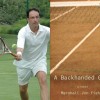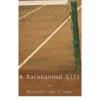What is the best tennis-themed novel of all time?
Some are already suggesting that Marshall Jon Fisher’s new book A BACKHANDED GIFT may just be that.
Fisher burst into prominence in the tennis world in 2009 with the release of his widely popular book A TERRIBLE SPLENDOR about the Don Budge – Gottfried von Cramm 1937 Davis Cup match at Wimbledon. He has now returned to the tennis literary scene with the release of A BACKHANDED GIFT ($19.95, New Chapter Press, available here on Amazon.com: http://www.amazon.com/A-Backhanded-Gift-Novel/dp/1937559149/ref=sr_1_1?ie=UTF8&qid=1361201222&sr=8-1&keywords=A+backhanded+gift. Set in the 1980s Germany with tennis as the backdrop, A BACKHANDED GIFT tells the story of aspiring writer Robert Cherney, who tries to navigate through getting over an erotic obsession from Lexa, a friend from New York, while starting his first novel and teaching tennis to a motley group of men at a Jewish tennis club in Munich. Love, tennis, sex, frustrated artistic ambition, and the dilemma of being a German Jew are all ingredients of this literary delight that is at times serious and comedic.
The following is a question and answer session with Fisher regarding the release of A BACKHANDED GIFT.
You had great success with your last tennis book A TERRIBLE SPLENDOR. Did that success prompt you to include tennis as a backdrop in A BACKHANDED GIFT?
Well, having grown up with tennis, I have found that it often seems to find a way into my work. I can’t say that there was any connection between the inspirations to write TERRIBLE SPLENDOR and BACKHANDED GIFT; they arose in completely different ways. With SPLENDOR, it was the realization that Bill Tilden, the personification of American tennis in the 1920s, who also happened to be gay, was coaching the Nazi German Davis Cup team in 1937, when Budge and von Cramm played their historic match. And then discovering the remarkable story of Gottfried von Cramm, who was leading the German team with a figurative gun to his head.It was such a great true story, and I knew I had the tennis background to tell it right.
A BACKHANDED GIFT, on the other hand, grew out my own experiences. As a novelist, you’re always looking for something unique in your own experience, outlook, or imagination that you can bring to your work. I haven’t seen much fiction about teaching tennis–or about tennis at all, really–so I felt I had something new to present.
Tell us about your personal experiences in tennis.
I grew up in Miami and started playing tennis when I was eight. I played a lot of junior tournaments, without too much success in singles, although I did win a number of tournaments in doubles. Oddly enough, I was something of a doubles specialist from the age of twelve on. I had a pretty good serve and good net game, and I was as slow as your grandma. So I’ve always been better at doubles. I played varsity tennis at Brandeis University, where we had a pretty strong Div. III team. I played #1 doubles several years, and ended up my senior year at #2 singles also. The Brandeis tennis team, notably, was coached by Bud Collins in the 1960s. But that was well before my time. We had some colorful characters on the team, but none quite like Abby Hoffman.
It sounds like the character Robert Cherney in A BACKHANDED GIFT is based a lot about your experiences teaching tennis in Munich. Is this right?
A college teammate who was from Munich got me a job after graduation teaching tennis at his club, and I spent part of two years there. So yes, the setting is certainly based on my time there. But of course the plot is fictional. Very little of what happens in the novel actually happened, and the characters do not correspond directly to any real people. If I had written about my real life in Munich, it would have been pretty boring. I wish I had had the romantic escapades in Munich that Robert Cherney has!
What was the tennis scene like in Germany when you were there?
I worked there in 1986 and 1988, just after the emergence of Becker and Graf. So I did witness firsthand the enormous tennis boom in Germany that followed the success of those two great players. It felt somewhat like the U.S. tennis boom in the 1970s, when I was learning the game in South Florida. All the clubs in Munich had teams, at various skill levels, to play against other clubs. At certain levels, they were allowed to hire pros to play for them, and many brought in American college players, like me, to coach and play. And at the highest level, as I think gets mentioned in my book, touring pros would even play for local clubs. What I remember most, however, is the pristine quality of the beautiful red-clay courts. Even the smallest public facilities had gorgeous clay courts that we’d die for here in the U.S.
Did you ever think of becoming a tennis journalist rather than a novelist?
Not really. I always wanted to write fiction primarily. But I learned soon enough that it’s almost impossible to make a living with fiction. So I began taking assignments for magazines. My first big break was in 1995 when the Atlantic Monthly accepted an essay I’d written about wooden tennis rackets. And I later wrote a piece for them about grass-court tennis (you could say I was the Atlantic’s tennis luddite), as well as one about racket technology for The Sciences. So in a small way I guess I was becoming a tennis journalist. And with A TERRIBLE SPLENDOR I made my own contribution to the writing of tennis history. And now I’ve been lucky enough to don a third tennis-writer hat, as a novelist. I loved having a press pass to the U.S. Open when I wrote those magazine pieces. Now I need to think of some good article ideas that might get me to the Australian Open and Roland Garros, the two majors I’ve never been to.
Do you plan to write any other tennis-themed books in the future?
Actually, the book I’m working on now–the details of which I don’t really want to reveal just yet–also has some tennis in it, and also takes place in Germany, in 1923. And its genesis was completely unrelated to that of either of these other two books. So without having intended to at all, I seem to be wrapping up a sort of German tennis trilogy.
What are your favorite tennis books?
Levels of the Game, John McPhee’s journalistic examination of the 1968 U.S. Open semifinal between Arthur Ashe and Clark Graebner, is of course the iconic tennis classic. And I do love that book. My all-time favorite, however, is probably A Handful of Summers, Gordon Forbes’s 1978 memoir of playing the world tennis circuit in the late 1950s and early 1960s. It’s certainly the funniest tennis book ever. In those days, when Wimbledon and all the other great championships were amateur, the tour was more collegial, as well as more attainable for a cast of colorful characters more interested in seeking life experience than in becoming multimillion-dollar groundstroke machines. As Forbes, a South African Davis Cup player, traveled the world with the likes of the inimitable Abie Segal, the brilliantly neurotic Tappy Larsen (who passed away recently, I was sorry to learn), and the jazz Buddhist poet Torben Ulrich (whom I had the great pleasure of meeting in San Francisco during my Terrible Splendor lecture tour), as well as players you’re more likely to recognize, such as Laver, Emerson, and Drysdale, he jotted down scenes and observations that will, I should think, entertain tennis fans forever. After reading Handful, you won’t be able to resist bragging of the “rare bit of arse” on your last volley, urging your partner to “put a bit of nudge on it,” or, best of all, querying your fuming buddy who’s also read the book, “What’s the matter, Drobs?” He’ll know just what you mean.
Fisher was born in 1963, grew up in Miami, and graduated from Brandeis University, where he played varsity tennis. He worked as a sportswriter in Miami and a tennis pro in Munich before moving to New York City, where he received an M.A. in English at City College. In 1989, he moved to Boston and began working as a freelance writer and editor. He has written on a variety of topics for The Atlantic Monthly, ranging from wooden tennis rackets to internet fraud, and his work has also appeared in Harper’s, Discover, DoubleTake, and other publications, as well as The Best American Essays 2003. His book “The Ozone Layer” was selected by The New York Public Library as one of the best books for teenagers of 1993. His book (with his father, David E. Fisher) “Tube: The Invention of Television” was published by Counterpoint in 1996 and by Harcourt Brace in paperback in 1997. Their second book together, “Strangers in the Night: A Brief History of Life on Other Worlds” (Counterpoint 1998), was selected by The New York Public Library as one of the 25 “Books to Remember” of 1998. Fisher now lives in the Berkshires of western Massachusetts with his wife and two sons. You can read more about him at www.marshalljonfisher.com.
Founded in 1987, New Chapter Press (www.NewChapterMedia.com) is also the publisher of “Roger Federer: Quest for Perfection” by Rene Stauffer (www.RogerFedererBook.com), “The Bud Collins History of Tennis” by Bud Collins, “The Education of a Tennis Player” by Rod Laver with Bud Collins, “The Greatest Tennis Matches of All-Time” by Steve Flink, “The Wimbledon Final That Never Was” by Sidney Wood, “Acing Depression: A Tennis Champion’s Toughest Match” by Cliff Richey and Hilaire Richey Kallendorf (www.CliffRicheyBook.com), “Titanic: The Tennis Story” by Lindsay Gibbs, “Jan Kodes: A Journey To Glory From Behind The Iron Curtain” by Jan Kodes with Peter Kolar, “Tennis Made Easy” by Kelly Gunterman, “On This Day In Tennis History” by Randy Walker (www.TennisHistoryBook.com), “A Player’s Guide To USTA League Tennis” by Tony Serksnis, “Boycott: Stolen Dreams of the 1980 Moscow Olympic Games” by Tom Caraccioli and Jerry Caraccioli (www.Boycott1980.com), “The Lennon Prophecy” by Joe Niezgoda (www.TheLennonProphecy.com), “Internet Dating 101: It’s Complicated, But It Doesn’t Have To Be” by Laura Schreffler, “Bone Appetit, Gourmet Cooking For Your Dog” by Susan Anson, “How To Sell Your Screenplay” by Carl Sautter, “The Rules of Neighborhood Poker According To Hoyle” by Stewart Wolpin, “People’s Choice Guide Cancun” by Eric Rabinowitz, and “Lessons from the Wild” by Shayamal Vallabhjee, among others.


